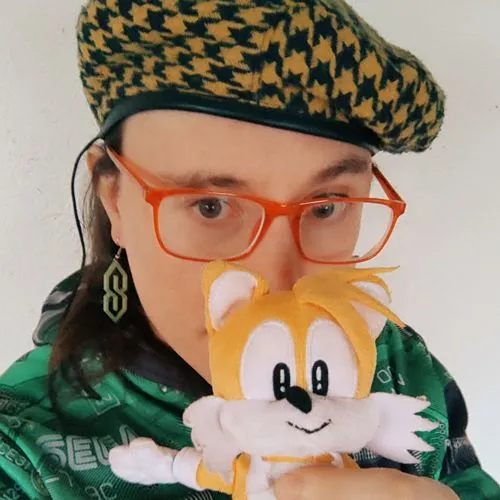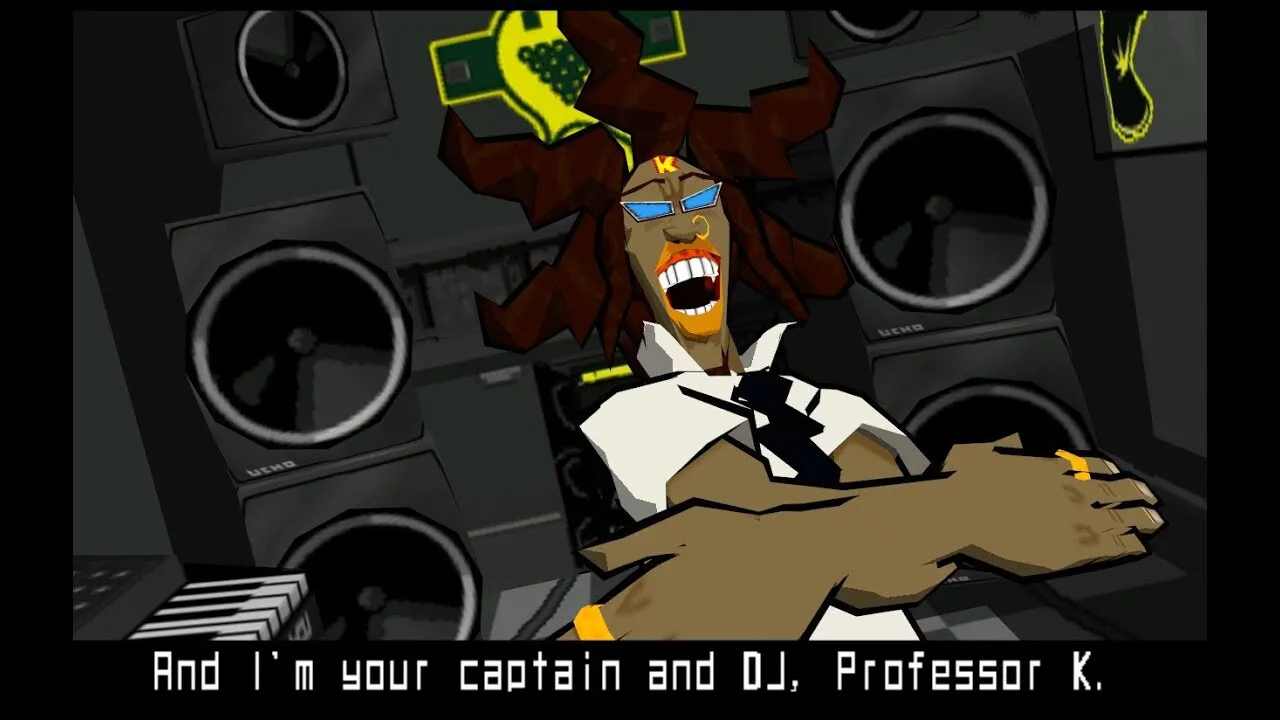Warning: This bark makes a passing mention about child rape / pedophilia allegations (regarding Michael Jackson), but not in a particularly distressing context: give this bark a chance if you can handle that.
On the few social media places i still frequent, you’ll generally catch me holding a little plushie of Tails, the little kitsune homie from Sonic the Hedgehog games.

Dozens of Sonic games, cartoon series, even a film, were scored by many different composers.
Some famous ones like Masato Nakamura, the composer of Dreams Come True, a big deal j-pop band, albeit obscure outside Japan.
The first games of the series were on the Sega Mega Drive (Genesis on Turtle Island), which had a characteristic pair of sound chips: the YM2612, an iconic 6-channel FM chip with an impossibly metallic timbre i love, and the more modest SN76489, a Programmable Sound Generator with 3 square waves and a noise channel generally used for accompaniment and sound effects.
Listen to one of Nakamura’s compositions, from the first game, with the sort of FM bells everyone loves:
But of course, if you ask me who are the greatest YM2612 composers, I’d have to name Yuzo Koshiro, whose challengingly abrasive house soundtrack for Bare Knuckle 3 (Streets of Rage 3 outside Japan), a collaboration with Motohiro Kawashima inspired by the sort of club music they were into in the mid-90’s, created in part with custom-written generative software, remains a must-listen to this day:
Yuzo Koshiro, decades laters, continues being a huge synth nerd, and the CEO of a small game development studio, Ancient Corp, who were indeed part of the dev team of Bare Knucke 2 and Bare Knuckle 3.
He has too many great works to list, but why not mention the iconic first stage of ActRaiser, composed for the competing console at the time, the Super Nintendo, showing off both the true potential of that console that favored sampling rather than FM synthesis, and Koshiro’s amazing stylistic range as a composer:
And since i get to name multiple YM2612 favs i just decided (my web blog my rules don’t like don’t read), i will namedrop HeavyViper—a composer who loves working with the YM2612 of the Sega Mega Drive to score modern games. He’s a cool guy and a great friend who makes amazing songs for indie games you might have played (if you like old-school arcade shooting games, that is):
And with that digression about sound chips out of the way, let’s talk about Sonic again. After Nakamura worked for Sonic 1 and Sonic 2, guess which celeb was next?
Michael Jackson—allegedly.
Until extremely credible allegations of child rape were made about him, expunging from the official record his collaboration. Kind of a good call.
This track, while not very exceptional, is of interest:
Brad Buxer, Michael Jackson’s producer, recycled its hook from a much better unreleased song from his short-lived new wave band, the Jetzons:
This is not the only instance of recycled sounds in the series. A much less known example is the song Bridge Zone from the Sonic the Hedgehog version released on the Sega Master System & Sega Game Gear—older, less powerful systems, to which the Sonic games were ported to reach players who still used those 8-bits systems.
It is almost certainly lifted from Step Daughter by Casiopea, a popular jazz fusion band that’s been around for half a century, with the lead guitarist Issei Noro the only remaining original member.
But let’s talk about Sonic again. One of the more surprising composers for the series was Hideki Naganuma, for the Nintendo DS games, whose style revolves around sampling, with uniquely cartoonesque hip-hop & funk stylings:
Do you recognize the samples in the opening? Yup. It’s an iconic speech by Malcom X:
But to be honest, Naganuma probably didn’t realize that - he’s a prolific English language shitposter on Twitter (now known as The Divorced Transphobic Guy’s Website). Naganuma’s politics are quite progressive, but he is not particularly politically outspoken about them. In fact, I am certain—being quite familiar with his œuvre—that most of his vocal samples come from the old school Akai Sampler CD Norman Cook - Skip to my Loops—Norman Cook being the artist you probably know better as Fatboy Slim:
Don’t begrudge the knowledge: the whole point of those sample CDs was to be used so.
Still, those sample CDs were full of obviously uncleared samples. They served as a way to launder your conscience about simply lifting a cool sound from somewhere. Which you should totally do because copyright is even more fictional than Mickey Mouse.
Naganuma is best known for his work on Jet Set Radio, a game so future at the time, its sequel had to call itself Jet Set Radio Future to clarify it was even more future.
Sadly, the series was never a commercial success, but they are uncontested classics.
The game was narrated by one DJ Professor K:

And true to this, the music in-game wasn’t simply a collection of tracks: the stages had actual DJ mixes. Here’s an example of a very noticeable and abrupt transition between two songs during gameplay, at 16:18:
Naganuma wasn’t the only composer on the soundtrack of Jet Set Radio. One band featured was Deavid Soul, a duo known almost only for their participation in this game, whose impossibly generically-named and illustrated Sparkling Music album of funky house provided many tracks for the game. One of my favorite has to be Miller Ball Breakers, never ask me what this title can possibly mean:
The song it samples is a wonderful early 80’s electro hip hop song by Pumpkin & the All-Stars. It lifts the break that starts at 3:05, but you simply must listen from the start:
As for whether Sega ever paid any royalties to the estate of Pumpkin, who sadly died a decade before the game was ever released, lol.
The previous video of Pumpkin comes from a TV show that is deep French lore.
H.I.P. H.O.P. was a short-lived, yet very influential TV program, that started and stopped airing in 1984. The host, Sidney Duteil, was the first Black host ever on French TV.
He’d attempt to rap his program.
Attempt is the keyword here. His horrifyingly nonexistent flow only adds to the charm of it all, though. And let’s be real: given the program’s budget, he almost certainly didn’t have the luxury of a backing track as he’d MC.
The episode I’m posting features a special treat: Sidney and Herbie Hancock not understanding each other’s language enough to meaningfully communicate, but ever the Mensch, Herbie doing his best to find something nice and tangentially related to say. Then a bunch of little kids breakdancing to Rockit, with Sidney’s vaguely on-beat MCing. This was clearly way too sincere to be allowed to live long on television.
You don’t need to understand any French to enjoy, though it helps:
I love this nerd. You might catch me somewhere on the front row in this video (i wasn’t gonna settle for anything less, and it’s surprisingly affordable if you buy months in advance). It was two years ago. The guy was 82 years old at the time, way too young to stop shredding the keytar the world over.
Must we really conclude? Let’s merely adjourn the journey.
Let’s part with a favorite video of mine, soon to be a favorite of yours:
Note: This bark was first published as a forum post in the Look Mum No Computer forums, of all places. This version was slightly reworded to be more pleasant to read and to assume less synth nerd knowledge.